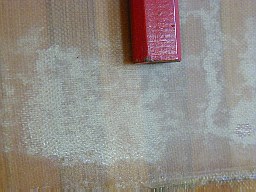
 |
|
 |
|
| This is what the panel looked like when it was new. The panel below reflects changes after two months outside. The third panel shows the epoxy after six month of continuous exposure to the elements. | |

Panel at 6 months (compare the light band in the middle) 
|
I have omitted the close-ups of the individual epoxies because the changes are too subtle to be picked up by the camera at this distance and displayed visibly at 72 dpi (dots per inch) monitor resolution. The plastic 'light shield' covered the middle band between the red dots at the edges of the photo. |
|
|
|
|
| Fabric
'whitening' - It was clear from the two month test
that fibers coated with a thin layer of epoxy showed signs of discoloration.
The thin epoxy coat has now succumbed to oxidation particularly on the blushing
epoxies such as the WS206 and the EastSys. Patches of the WS206 are severely
eroded from water penetrating into the fibers which caused complete delamination
of the 'filler' layer of epoxy. It is interesting to note that the WS206
is supposedly more water resistant than the WS207 but it just doesn't stand
up well to UV radiation. The whitening of the fibers on the other samples
has stabilized and is not much worse than it was four months ago. Erosion of WS206 below:  click
on image for magnification click
on image for magnification |
|
|
Color changes and
surface oxidation- |
|
| . |
Epoxy shrinkage
- All epoxies show substantial shrinkage and fabric print-through. Here
is an example of Raka print-through. |
|
Varnish 'water resistance'
- The varnish is holding up really well and I can't discern much change
except a slight "loss of gloss". |
|
|
|
| Home | Kayak Designs | Kayak Shop | Materials | Kayak Gallery | About us |
| Building Manual | Plans | Sandwich Core | Wood Kayak | Order | |
| Epoxy Test | Abrasion Cloth | Rudder | Resources | Choosing Kayak | Guestbook |
If you notice any problems with the site (i.e. error links, missing images) please, let me know. Thanks
Mail:
Vaclav Stejskal
58 Wood Ln.
Acton, MA 01720
USA
Tel: 781-481-9261
© 1999
- 2024 Copyright Vaclav Stejskal
All rights reserved
Last page update:
9 May 2024